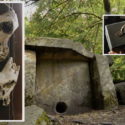The Mysterious Egyptian Sistro That Could Open Portals And Change Climate?
Because it appears alongside the ‘false doorways’ of ancient Egyptian temples, some believe the sistro serves as the gods’ entry and exit from one area to another (portals). This led to the assumption that the Egyptian gods’ artifact can open doorways.
The sistro was one of ancient Egypt’s most holy musical instruments, utilized not just to create strange sounds but also for religious purposes. It was thought to have magical abilities, such as the ability to pacify frightening gods and ameliorate the environment. Let’s take a closer look at the instrument’s history and significance.
In ancient Egypt, the sistro was used.
The sistro was originally an instrument used by the gods; it can be seen in the hands of the goddesses Isis and Bastet, but it is most closely associated with Hathor, who is known as the “lady of the stars” and “Sovereign” of the stars, linked to the Syrian star, and a representative of the Egyptian gods’ origins.

The sistro, which was regarded as a mystical instrument, was also employed officially and permanently in the worship of the goddess Hathor, who was the goddess of sexuality and dancing and aroused joy, festivity, and fertility. Depictions of the goddess Hathor holding a holy sistro have been discovered.
Similarly, the Egyptians utilized the sistro to try to keep the Nile River from exceeding its banks and generating floods that destroyed agricultural areas. Furthermore, the sound created by this instrument was said to frighten Seth, the god of the desert, storms, violence, and chaos.
In addition, the goddess Isis was shown as the creator and mother, holding a bucket that signified the Nile waters in one hand and a sistro in the other. This musical instrument played a significant role in Egyptian followers’ religious rites.
As a musical instrument, the sistro
The sistro is a very archaic musical instrument that comprises metal plates put in rods and is shaped like a bow or horseshoe. It generates a sound comparable to a breeze blowing through papyrus reeds when shaken violently. Egyptians and other Middle Eastern cultures characterized it in this way.
Sistro is derived from the Greek word sinio, which means “to shake.” The instrument was given the name sixtron, which alludes to anything that is being shaken. It belongs to the same idiophone family as other well-known percussion instruments including bells, castanets, and maracas.
The sistro and its etymological significance
Furthermore, by employing the sistro, an attempt was made to regulate and pacify nature’s destructive powers. It was also a way to sway the gods, whether to appease, revere, or even terrify and reject them. It would be a stretch to describe the sistro as a cult object or even an amulet.
The sound of the instrument was also thought to be protective and symbolic. It was associated with heavenly benediction and the notion of rebirth, not only because of the symbolic significance of its sound, but also because of the shape and decorating of the artifact, which was tied to the gods.
The sistro from Egypt
So far, two types of this ceremonial instrument have been identified: the sistrum naos,’ which had Hathor’s head and was placed in a tiny shrine or box in the shape of the naos, and the sistrum naos,’ which had Hathor’s head and was placed in a little shrine or box in the shape of the naos (inner chamber of a temple that houses a cult figure). Hathor’s head is frequently represented on the hilt, with a pair of cow horns incorporated into the design (Hathor is commonly described as a cow goddess).
A second sort of sistro became popular throughout the Greco-Roman period. This sistro, also known as sekhem or sekham, featured a basic arch-shaped framework made of metal. On top of Hathor’s head, the sekhem resembled a closed horseshoe with a long handle, with loose, crossed metal bars.
A magnum and a semicircular construction composed of brass, copper, wood, or clay make up the sistro. Small hoops are implanted in moving crossbars, and as the instrument swings, the sound is a combination of a booming clink and a quiet beat.

The ancient Egyptian sistro had a basic form that resembled the Egyptian ankh or cross, as well as the face and horns of a cow. Women and high priestesses are often seen carrying a sistro in ancient depictions.
A musical instrument having mystical and religious connotations
It may be seen in a variety of prints and murals all around Egypt. This relic may be located inside Hathor’s temple, near to the Lamp or Bulb Dendera, shown in four sistros that appear to indicate that it was connected to energy, vibration, and some form of ancient technology.
Since it is present in the false doors of ancient Egyptian temples, some unusual interpretations even link the sistro to the gods’ entry and escape from one location to another. This may be seen in Karnak, where there is a structure of seven doors with a sistro depicted on the side. Which raises the question: did the ancient Egyptian gods have the power to open gateways with this artifact?
Murals and documents may now be discovered depicting Isis priests or their attendants carrying a sistro. According to some studies, music may be used to induce trance states in which priestesses and priests can “commune” with entities from other planes of awareness.
After the pharaohs vanished, the sistro continued to be used in Egypt. Sistros were also utilized in Greek culture, although not all of them should be performed. Instead, they were used solely as a symbol in sacrifices, festivals, and funerals.
The sistrum is still used in Coptic and Ethiopian churches for rites today. It is performed during the debtera (singers) dance during big church festivals. It can also be found in Neopagan rites and worship.
Without a doubt, the sistro is a fantastic and magical artifact that demonstrates that the Egyptians were a culture full of fascinating mysteries and tales. A musical instrument having mystical and religious connotations



